Located in Naples, Pompeii is the world’s largest archaeological site, attracting 2.5 million annual visitors.
Covering an area of 60 hectares (145 acres), this site gives its visitors a glimpse into Roman life nearly two millennia ago.
People planning to visit Pompeii often wonder what the best things to do in Pompeii are. Are there any activities or places to visit nearby?
Yes, there are some must-see places in Pompeii and popular attractions in its surrounding areas, like the scenic Amalfi Coast.
In this article, we will discuss Pompeii’s highlights, along with the best places to see and things to do nearby.
Things to Do in Pompeii
Here are the best things to do in Pompeii and surrounding areas:
1. Visit the Amphitheater
- Opening Hours: 9 am to 7 pm
- Location: Piazza Immacolata, 80045 Pompei NA, Italy
One of the most popular and best things to do in Pompeii is to see its amphitheater, the oldest known in ancient Rome.
Unlike traditional semi-circular Greek amphitheaters, it is circular, providing a 360-degree view.
The amphitheater, built in 70 B.C. by the magistrates Caius Quinctius Valgus and Marcus Porcius, could hold 20,000 people.
Earlier, they hosted gladiator games and many events in the amphitheater, just like the Colosseum in Rome.
During one event in A.D. 59, the crowds got so rough that a huge brawl broke out between the spectators, resulting in its closing for many years.
Some may even remember this amphitheater since it hosted the Pink Floyd concert in 1972!
2. Pray at the Temple of Apollo

The Temple of Apollo is one of the city’s oldest and most important religious sites. It is dedicated to Apollo, the Greek and Roman god of music, healing, and the sun.
The temple’s design dates back to the 6th century B.C., and it perfectly combines Greek and Roman architectural styles.
It is located near the forum, and you can easily access it anytime.
- Opening Hours: 8 am to 8 pm
- Location: Santuario di Apollo, Via Villa dei Misteri, 4, 80045, Pompei NA, Italy
The temple was a central place of worship in earlier times and played an important role in the daily lives of Pompeii’s residents.
A grand courtyard surrounded by columns, an altar where sacrifices were made, and the remains of beautiful statues once stood in the temple complex.
You can walk through its ruins, where you’ll notice the detailed carvings and the half-broken large columns that have stood for centuries.
You can pray at the temple and also learn how the ancient Romans honored their gods.
3. See the Bathhouses
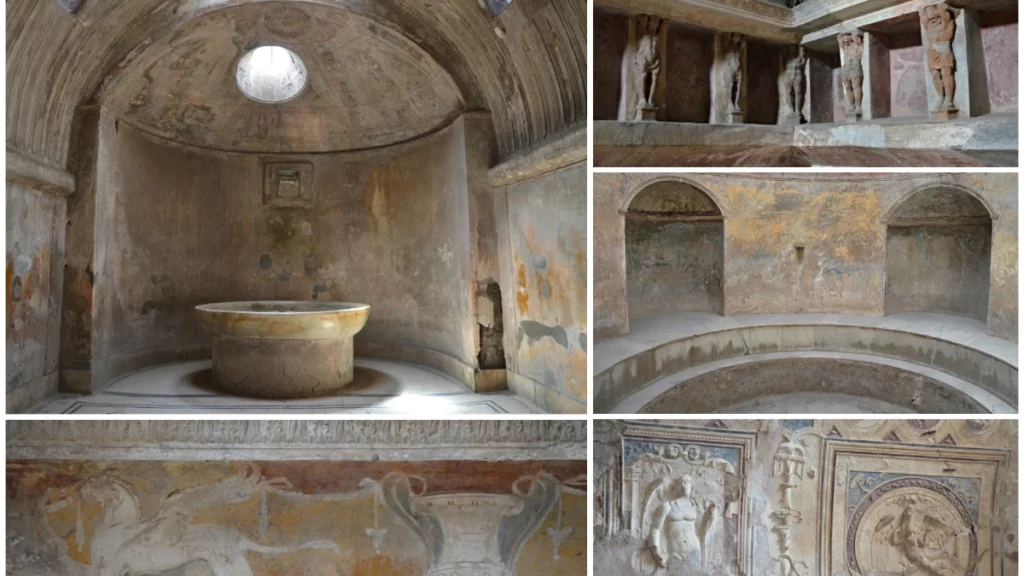
Opening Hours: 9 am to 7 pm
Pompeii has undoubtedly stunning architecture, way ahead of its time.
Bath complexes, such as the Forum and Stabian Baths, reflect the luxurious lifestyle of the ancient Romans.
Forum Baths
You can see the Forum Baths near the city’s central square.
Forum Baths were large public bathhouses used by both men and women and were known for their facilities and elegant architecture with marble decorations.
There, you’ll see well-preserved rooms for hot, warm, and cold baths, known as the caldarium, tepidarium, and frigidarium.
Stabian Baths
If you think swimming pools are a thing of the modern world, then you must see this!
In Pompeii, there is another kind of bath complex called the Stabian Baths, covering an area of over 10,000 square meters.
These baths are among the oldest in the city, dating back to the 2nd century BC.
The Stabian Bath complexes include a large swimming pool, exercise areas, and beautifully decorated bathing rooms.
They were not just for bathing but also served as a social hub where people gathered to relax and converse.
Suburban Baths
In addition to the Forum and Stabian Baths, Pompeii also had other smaller bathhouses called the Suburban Baths.
They were located on the outskirts of the city and are known for their well-preserved frescoes and private rooms.
These bathhouses tell us how ancient Romans maintained their hygiene, socialized, and enjoyed their time together.
4. Exercise at the Pompeii Gym
- Location: Palaestra Grande, Via Roma, 44, 80045 Pompei NA, Italy
- Opening Hours: 8.30 am to 7:30 pm
Just like the swimming pool, the concept of the gym is also not new!
You can see the ancient gym in Pompeii, the Palaestra Grande, where ancient Romans, both men and women, exercised and played sports.
Men would lift weights, wrestle, fence, box, and play ball games like handball.
Women also participated in exercises like playing a game called Trochus, which involved pushing a metal loop with a hooked stick.
The Palaestra was built in the Augustan period, at the beginning of the 1st century AD, and has a swimming pool at its center.
Besides exercising, the Palaestra was also a place to relax, socialize and share things.
5. Visit the Forum of Pompeii
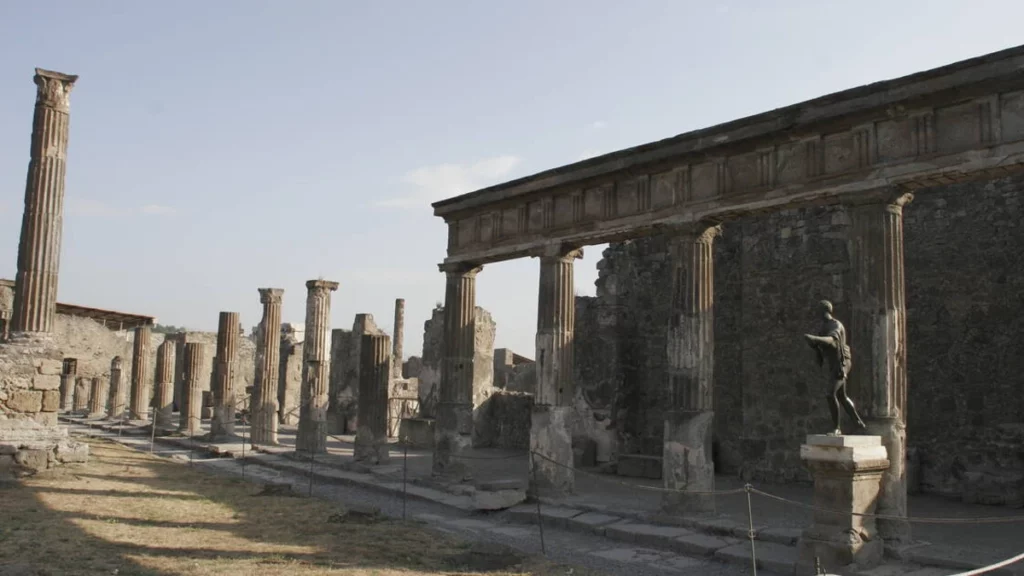
- Opening Hours: 9 am to 5 pm
- Location: Foro di Pompei, Via Villa dei Misteri, 2, 80045 Pompei NA, Italy
One of the most important things to see in Pompeii is its Forum.
Built between the 3rd and 2nd centuries B.C., the Forum was a central public square that hosted various activities.
It was well-surrounded by other important buildings, such as the Temples of Venus, Apollo, and Jupiter, and provided a stunning view of Mount Vesuvius.
At the forum, people gathered to discuss important political, commercial, and social matters.
6. View the Antiquarium
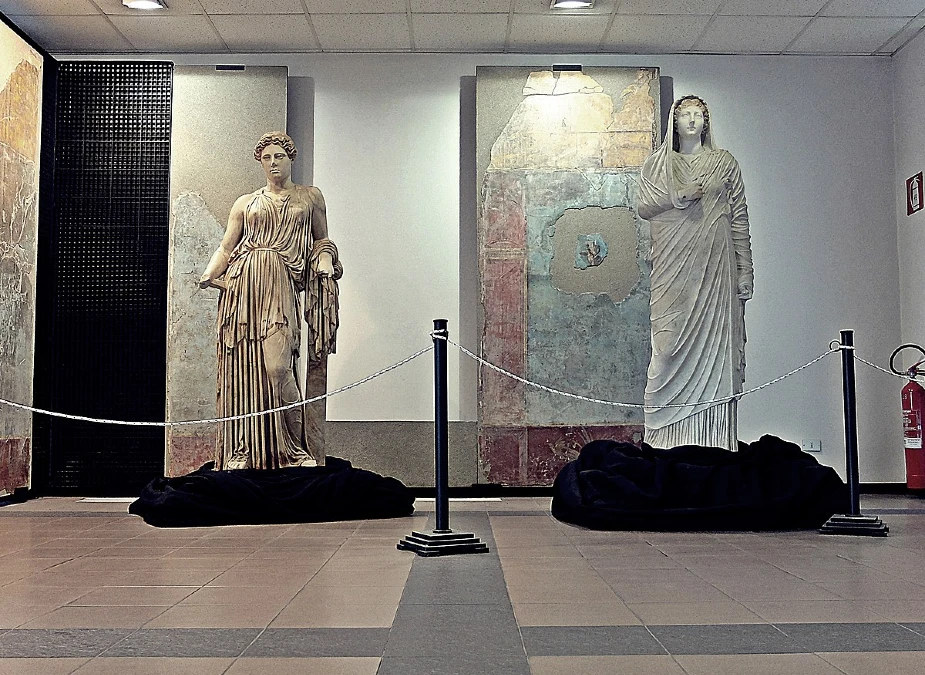
- Opening Hours: 9 am to 4 pm
- Location: Antiquarium di Pompei, 80045 Pompei, Metropolitan City of Naples, Italy
Constructed by Giuseppe Fiorelli between 1873 and 1874, the Antiquarium is located at the entrance to the archaeological site.
You can see it just below the terrace of the Temple of Venus, overlooking Porta Marina.
The antiquarium displays a variety of items, including household objects, tools, and decorative art from ancient Rome.
In addition, you can see the plaster casts of the people who tried to escape the volcano’s destruction.
The Antiquarium serves as a museum that lets you learn more about the life and destruction of Pompeii.
7. Go inside the House of Vetti and Fawn
- House of Vetti Location : Vicolo dei Vetti, 80045 Pompei SA, Italy
- House of Fawn: Via Villa dei Misteri, 2, 80045 Pompei NA, Italy
The House of the Vettii and the House of the Faun are the two best-preserved ancient Roman houses in Pompeii. You can go inside both of them.
Excavated between 1894 and 1895, the House of the Vettii belonged to a wealthy merchant family.
It featured well-decorated rooms with an open courtyard and statues with jets of water.
The house also had a living room where the main activities of that time were performed, such as selling wine, cleaning clothes, making jewelry, and creating perfumes.
Similarly, the House of the Fawn is another large Pompeii home, covering over 3,000 square meters. It was built in the 2nd century BC.
It was also owned by a wealthy family. The house has a main atrium with an exact copy of the famous statue of the dancing faun.
8. Perform at the Grand Theater
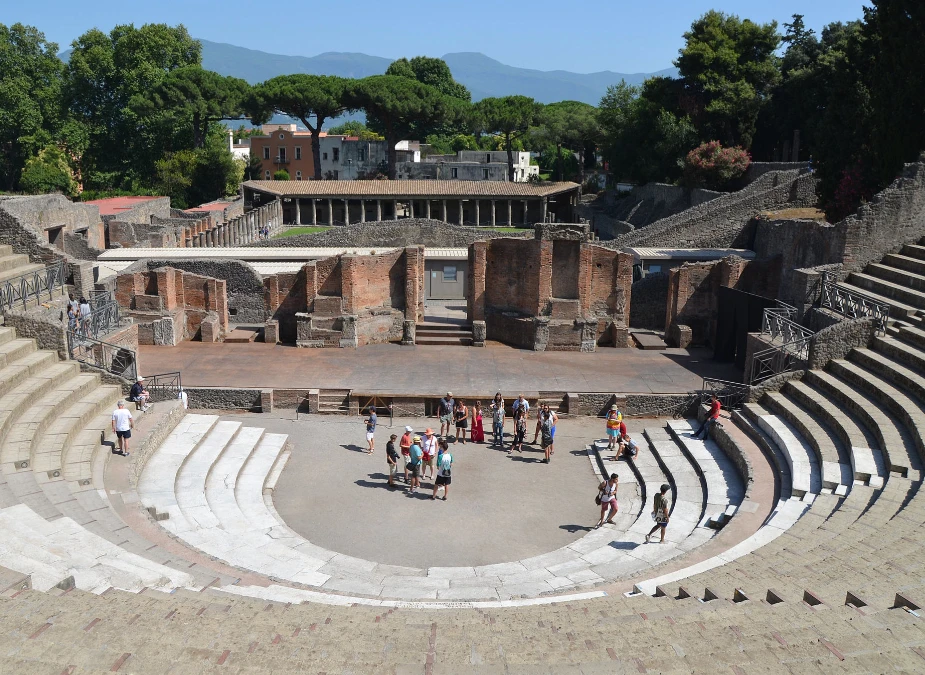
- Opening Hours: 7 am to 7 pm
- Location: Teatro Grande, 80045 Pompei, Metropolitan City of Naples, Italy
The amphitheater was a place for entertainment and community gatherings in Pompeii. However, it was not the only hub.
The ancient Romans also performed at the Grand Theater in Pompeii, called the Teatro Grande.
Situated in the southwest part of the city, it was one of the three main buildings in the theatre area, along with the Odeon (a smaller theatre) and the Amphitheater.
Built around the middle of the 2nd century BC, the Grand Theater could hold 5,000 visitors.
It hosted events like musical concerts, political assemblies, tragic and comedic plays and a wide range of activities.
It was among the first large public structures to be uncovered after the eruption of Mount Vesuvius.
Before visiting the Grand Theater, visitors may also see the grand staircase leading to the Triangular Forum.
9. Explore the paintings at the Villa of Mysteries
- Opening Hours: 8 am to 8 pm
- Location: Via Villa dei Misteri, 2, 80045 Pompei, NA, Italy
As the name suggests, the Villa dei Misteri, or Villa of Mysteries, is an ancient Roman villa in Pompeii.
Dating back to the 2nd century BC, it is known for its beautiful walls and floors, which are well-decorated with colorful paintings and frescoes.
One of the most famous parts of this villa is Room 5, where a painting of a young girl joining a secret club hangs.
There are many mysteries around the villa, like how some of those people worshipped Dionysus, the god of wine.
An earthquake occurred in 62 AD, destroying the villa. After that, it was used as a farmhouse where people made and sold wine.
Later, around 1909 and 1910, a person named Giuseppe Spano found this villa while digging around and today, we can still see its walls, ceilings, and beautiful paintings.
10. See the Brothels in Pompeii
- Opening Hours: 9 am to 5 pm
- Location: Intersection of two side roads on Via dell’Abbondanza
In Pompeii, brothels were places of luxury for the wealthy, but the reality for the workers there was sad.
The most famous brothel in Pompeii is called the “lupanar,” which means “den of she-wolves” in Latin.
This name comes from “lupa,” or “she-wolf,” which was slang for “prostitute” in ancient Rome. This brothel had two floors.
The owner and the prostitutes slept upstairs, while downstairs, there were five small rooms with built-in beds separated by curtains.
In brothels, there were many of the sex workers who were slaves living in tiny cells.
Today, you can see well-preserved and erotic art painted on the walls, showing the services offered.
Things to do Near Pompeii
If you have visited Pompeii and are looking for things to do near Pompeii, here are a few places you must visit:
1. Explore Herculaneum
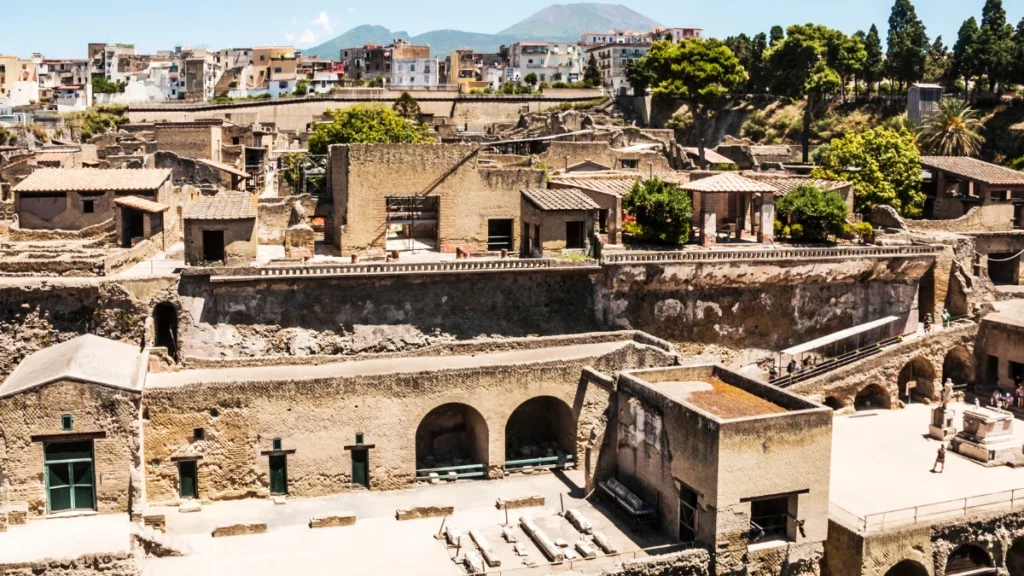
Distance: 19 km
How to Reach: Metro Line L4 Get Directions→
Opening Hours: 8.30 am to 7.30 pm
After seeing Pompeii, you can explore the nearby Herculaneum site, which was also destroyed during the Mount Vesuvius volcano.
Herculaneum is a smaller but wealthier town compared to Pompeii, located a few miles apart.
It has impressive houses, courtyard gardens, public baths, and dining areas. The Villa of the Papyri is located on the seafront.
2. Hike Mount Vesuvius
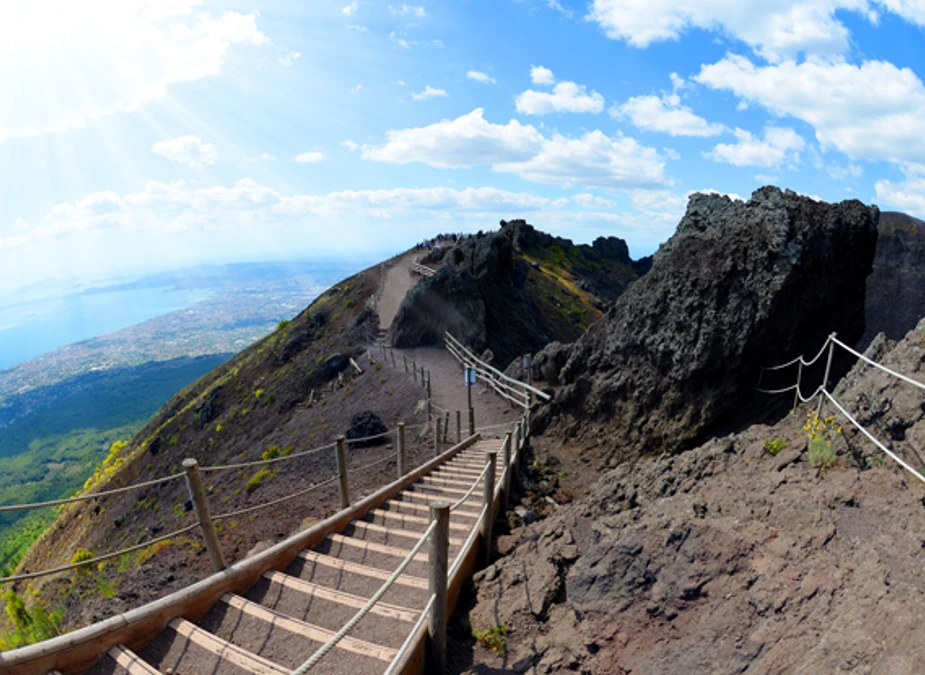
Distance: 25 km
How to Reach: Buses: Busvia del Vesuvio, EavBus/ Sita Public or Vesuvio Express Get Directions →
Opening Hours: 9 am to 5 pm
After Pompeii, you can also take a visit to the nearby Mount Vesuvius, the volcano responsible for Pompeii’s destruction.
You can also hike one of nine natural paths around the volcano or walk along the edge of the crater with a guide.
The place looks surreal and offers stunning pictures with views of the Gulf of Naples.
3. Visit the Paestum
Distance: 68 km
How to Reach: Train via Salerno
Opening Hours: 8.30 am to 7.30 pm
Paestum is another archaeological site known for its well-preserved Greek temples.
It includes two sacred areas and a public space with temples, private houses, and public squares.
After Pompeii, you can go to Paestum to learn about ancient Greek culture.
FAQs
1. What activities did they do in Pompeii?
People in Pompeii engaged in various activities, including attending gladiator games at the amphitheater, worshipping at temples, socializing and bathing at the public bathhouses.
They also exercised at the Palaestra and enjoyed performances at the Grand Theater.
2. Are there baths in Pompeii?
Pompeii has several well-preserved bathhouses, including the Forum Baths, Stabian Baths, and Suburban Baths.
These were places where ancient Romans bathed, socialized, and relaxed.
3. How big were the Stabian baths?
The Stabian Baths covered an area of over 10,000 square meters and included a large swimming pool, exercise areas, and beautifully decorated bathing rooms.
4. Is Pompeii worth visiting?
Yes, Pompeii is worth visiting, especially for those interested in the history and lives of the ancient Romans.
It has well-preserved ruins, buildings, and artifacts.
5. What is the neighboring town of Pompeii?
Herculaneum is a nearby town that also suffered from the eruption of Mount Vesuvius. It also has well-preserved buildings and artifacts.
6. What major city is Pompeii close to?
Naples is the major city close to Pompeii, located about 30 minutes away by train or car.
7. Is there anything else to do in Pompeii?
Yes, there are many things to do in Pompeii, such as seeing the paintings at the Villa of Mysteries, going inside the House of the Vettii, and visiting the brothels.
8. Can I do Pompeii and Herculaneum in one day?
While it’s possible to visit both Pompeii and Herculaneum in one day, it’s recommended that you do them on separate days to avoid exhaustion.
Featured Image:



